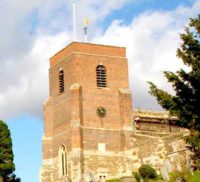The Walls
The main structural frame of the church needs constant maintenance. There is a continuous battle between need and the availability of money to fund the repairs. The work has to be carried out by specialist masons working to regulations set by the Diocese in consultation with other bodies, such as English Heritage.

Outside
The walls of the church are of ironstone, a type of Clophill sandstone commonly found in Bedfordshire. It is strong when under compression, making it a good building stone but it is quite soft and suffers surface damage easily. The whiter stone seen on the walls is Clunch, a soft stone from Totternhoe, South Bedfordshire. It does not weather well and needs constant replacing. The shaped stone blocks are laid with a specially compounded lime mortar which is chemically compatible with the stone thereby reducing corrosion over time. This mortar is not as strong as modern cement mortar and is used so that the building can move and breathe. Modern mortar would form a more rigid bond but the stones themselves would be likely to crack and require replacing rather than just re-mortaring.
Typically, the walls of old buildings need attention to maintain their integrity. Our most recent major work was in 2010, when eroded blocks on the south wall were replaced and the wall repointed. The work took about four months and the church was covered with scaffolding for the duration.
There will always be a need for ongoing stonework repairs.

Constant erosion of the stone surrounds of the north door and the door to the Lady Chapel has reached the stage where they must be repaired. We are hoping to start this work in 2023.
Inside
In common with most churches of this age, the walls are a mixture of bare stone with a plaster facing. A combination of chemical reaction and damp has led to the plasterwork crumbling.

As can be seen, especially to the north and south aisles, deteriorating plasterwork will need attention and renovation soon.
Damp courses were not a common feature of 14th century churches, consequently damp can rise up the walls, attacking the plaster from below. In modern churches where some form of heating is installed, the drying out of the air can cause damp to rise and special measures need to be taken to minimize its effect. At All Saints’ this has meant the installation of external and internal drainage and ventilation channels at the back of the church.
The Lady Chapel
In the Lady Chapel, the plaster and stonework was badly decayed and had to be renovated. This work was completed in 2013 with the existing plaster being removed, the walls cleaned up and replastered.

Looking to the future
Renovation work is continually needed. As well as projects already noted, this will include repairs to the pew deck where some of the old boarding has been attacked by woodworm and is suffering from continual wear over the centuries.


